
The Resilient Design of Wagner Park: An Overview
In the heart of Lower Manhattan, the newly designed Wagner Park stands as a testament to innovative architecture and urban design that addresses the pressing challenges of climate change. Conceived by Thomas Phifer and Partners in collaboration with AECOM, this park combines aesthetics and functionality, particularly flood resilience. The centerpiece is a striking red concrete pavilion, which embodies flexibility and sustainability, offering both visual appeal and practical utility.
A Gateway to Nature and Community
The Wagner Pavilion, resembling a pair of lungs, serves as a gateway to the park and offers breathtaking views of significant landmarks such as the Statue of Liberty and Ellis Island. This architectural marvel not only provides a space for a restaurant and classrooms but also integrates a rooftop garden. Such multifunctionality is increasingly vital for urban parks, particularly in bustling cities like New York, where open spaces facilitate community interaction and engagement.
Engineering Against Flooding: What It Means
Flood resilience is the core mission of the Wagner Park project. With the constant threat of rising sea levels due to climate change, the park's design cleverly employs various flood protection measures, including strategically placed flood walls and drainage systems. AECOM’s Gonzalo Cruz emphasized the need for such innovations, stating that the park showcases a blend of practical infrastructure and inviting public spaces, effectively preparing communities for unpredictable climate impacts.
Learning from Global Trends: Flood Resilience in Urban Design
Wagner Park isn’t operating in isolation; it represents a global movement towards integrating flood resilience into urban planning. Cities worldwide are investing in similar initiatives. For instance, Copenhagen’s efforts emphasize landscapes that adapt to flooding without sacrificing public enjoyment. These comparisons highlight that adaptive design is not just a local concern but rather a global necessity as flood-prone areas seek to protect their communities while enhancing the urban experience.
The Impact of Well-Designed Workspaces
The ergonomics of public spaces like Wagner Park can also inspire our remote work environments. By noticing how the pavilion encourages social connections and activity, digital nomads can incorporate elements like communal areas and natural light into their home offices or coworking spaces. Just as the pavilion is designed for flexibility and interaction, a workspace that invites engagement can foster productivity and well-being in turn.
The Future of Urban Parks: Community-Centric Spaces
As we consider the future of urban parks, the attributes of Wagner Park serve as a blueprint. Parks must be more than just green spaces; they should foster community interaction, provide educational opportunities, and ensure safety against environmental threats. This multifaceted approach not only enhances local quality of life but also cultivates a sense of ownership and responsibility among residents.
In observing the success of Wagner Park, it becomes clear that urbanists, architects, and community leaders must collaborate to create spaces that are resilient, adaptable, and supportive of both ecological and social functions.
 Add Row
Add Row  Add
Add 




Write A Comment